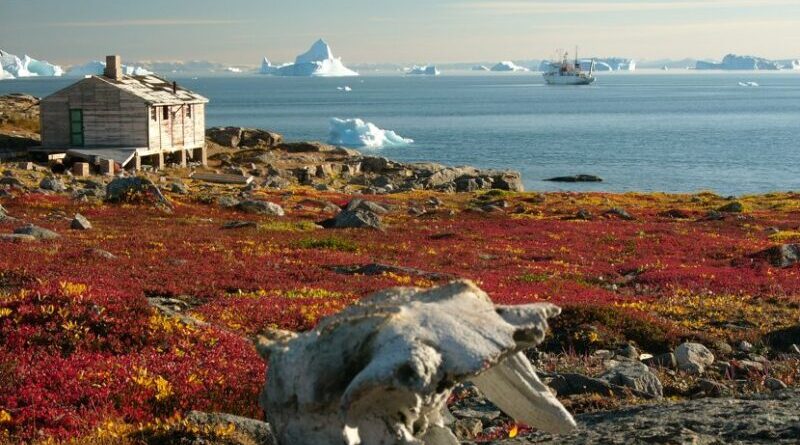Methane From Tundra, Ocean Floor Didn’t Spike During Previous Natural Warming Period
Scientists concerned that global warming may release huge stores of methane from reservoirs beneath Arctic tundra and deposits of marine hydrates – a theory known as the “clathrate gun” hypothesis – have turned to geologic history to search for evidence of significant methane release during past warming events.
A new study published this week in the journal Nature suggests, however, that the last ice age transition to a warmer climate some 11,500 years ago did not include massive methane flux from marine sediments or the tundra. Instead, the likely source of rising levels of atmospheric methane was from tropical wetlands, authors of the new study say.
While this certainly is good news, the study also points at a larger role of humans in the recent methane rise, noted Edward Brook, an Oregon State University paleoclimatologist and co-author on the study
“Our findings show that natural geologic emissions of methane – for example, leakage from oil seeps or gas deposits in the ground – are much smaller than previously thought,” Brook said. “That means that a greater percentage of the methane in the atmosphere today is due to human activities, including oil drilling, and the extraction and transport of natural gas.”
The study suggests that human emissions of geologic methane may be as much as 25 percent higher than previous estimates. Although not as abundant as carbon dioxide, methane is a much more powerful greenhouse gas and therefore the rising levels are an important contributor to global warming.
“This means we have even more potential to fight global warming by curbing methane emissions from our fossil fuel use,” said Vasilii Petrenko, an associate professor of earth and environmental sciences at the University of Rochester, and lead author on the study.
Anthropogenic methane emissions are the second largest contributor to global warming after carbon dioxide, but there has been uncertainty as to the source of that methane and whether it has changed over time, Brook noted. The new study sheds light on the issue by analyzing levels of atmospheric methane from the last deglaciation in air bubbles that have been trapped in pristine ice cores from Antarctica’s Taylor Glacier.
The researchers were able to estimate the magnitude of methane emissions from roughly 11,500 years ago by measuring radioactive carbon isotopes in methane, (carbon-14, also known as 14C or radiocarbon), which decay fairly rapidly. Methane released from those marine hydrates and permafrost is old enough that any 14C originally present has now decayed away.
They found that amount of methane from ancient “14C-free sources” was very low – less than 10 percent of the total methane – during the entire range of sampling, from 11,800 to 11,300 years ago.
“A lot of people have painted the Arctic as a methane time bomb,” Brook said, “but this shows that it may be more stable than we thought. Past performance isn’t always a predictor of the future, but it is a good analog. We should be more concerned about anthropogenic sources of methane into the atmosphere, which continue to increase.”
The levels of 14C in the ice cores suggest that the increase in methane during the last deglaciation had another source – likely from tropical wetlands, said Christo Buizert, an Oregon State University researcher and co-author on the paper.
“Methane is not stored in the tropics for long periods of time, but produced every day by microbial activity in wetlands,” Buizert said. “We know from other studies that rainfall increased in the tropics during the last warming period, and that likely created wetlands that produced the increase in methane during the last warming period.”
Atmospheric methane has increased from 750 parts per billion in the year 1750 to more than 1,800 parts per billion today – mostly from anthropogenic sources, especially leakage from fossil fuel production, the creation of rice paddies, and cattle ranching, the researchers say.
“All of the natural gas that we mine is very old and leaking inevitably occurs during that process,” Brook said. “Natural gas is considered a cleaner energy source than coal, but it can be a significant problem depending on how much of the methane is leaking out.”
The key to documenting the source of atmospheric methane is the pristine ice cores of Taylor Glacier in Antarctica, where dry, windy conditions have allowed this ancient ice to be slowly brought to the surface. One reason scientists had yet to pin down the sources of methane during the last ice age is that the amount of 14C is so small, it takes enormous amounts of ice to get enough air to measure the isotope.
In fact, it takes some 2,000 pounds of ice, running a melting instrument over three days, to get enough air to produce one sample of measurable 14C. Drilling down in the center of the ice sheet to find that much ice from the end of the last ice age would be prohibitively costly and labor-intensive, but the unique conditions at Taylor Glacier – pushing that old ice toward the surface – made it possible.

